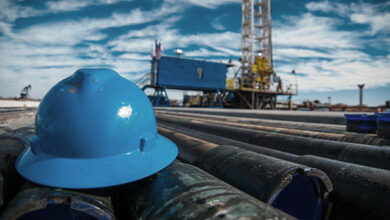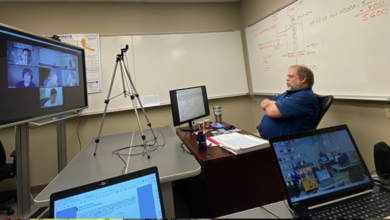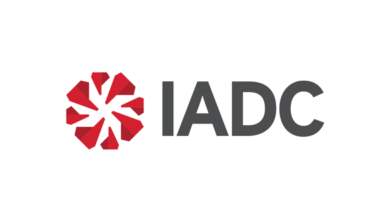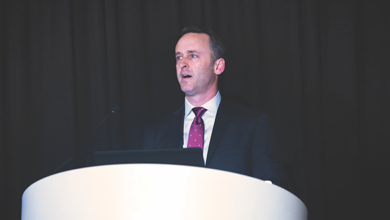Drilling & Completion News
Noble, ExxonMobil execute agreement for drilling services in Guyana-Suriname
Noble Corp and ExxonMobil have announced the execution of a commercial enabling agreement for drilling services in the Guyana-Suriname Basin. The agreement defines contract terms for the continuation of drilling services using certain drilling units in Noble’s fleet.
The ultra-deepwater drillships Noble Bob Douglas, Noble Tom Madden and Noble Don Taylor, which are currently executing drilling assignments for ExxonMobil offshore Guyana, are included in the framework agreement, and other drilling rigs may be added.
The Noble Bob Douglas is located on the Liza Phase 1 development project in the Stabroek Block, while the other drillships are assigned to exploration drilling in the region.
Under the agreement, dayrates for each rig will be updated at least twice per year to the prevailing market rate, subject to a scale-based discount and performance bonus.
Further, ExxonMobil has awarded 3.5 years of term to be added at the conclusion of each rig’s current contract commitments. The agreement also provides for allocation of six additional years dependent on future development decisions and government approvals, as well as the potential for incremental contract term, or rigs as required.
Talos hires Transocean drillship for US GOM program
Talos Energy has contracted the Transocean Discoverer Inspiration for its 2020 deepwater drilling and completions program in the US Gulf of Mexico. The ultra-deepwater dual-activity drillship will assist with the Bulleit completion and tieback project, development activity in the Phoenix complex, and potentially one or more “high-impact” exploration drilling projects under evaluation.
ADES jackups win additional work in Saudi Arabia
ADES has secured a contract renewal for the ADMARINE 262 jackup in Saudi Arabia. The renewal covers a five-year period, which will be effective upon expiration of the current contract in April. ADES also recently announced that a service provider has extended its contract for the ADMARINE 261 jackup by one year in Saudi Arabia.
Keppel delivers Heimdal jackup rig to Borr Drilling
Keppel FELS has delivered the Heimdal, a jackup rig built to Keppel’s KFELS B Class design, to Borr Drilling. It is the fifth of 11 jackup rigs that Borr has ordered from Keppel.
Simmons Edeco wins onshore drilling contract in Mexico
SIMMONS EDECO has been awarded a contract in Mexico to drill a series of onshore directional wells, with target depths in the 3,000-m range. The new wells are the first phase in a major development in southeastern Mexico. The contract is scheduled for completion in early 2020.
Equinor and Shell jointly acquire Schlumberger’s 49% interest in Vaca Muerta’s Bandurria Sur block
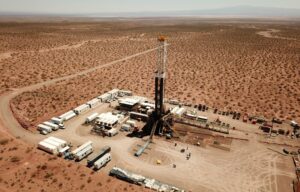
Equinor and Shell have completed a joint acquisition of the 49% interest held by Schlumberger in the Bandurria Sur onshore block in Argentina’s Neuquén province. The consideration for each partner for their 24.5% interest is $177.5 million.
The block covers approximately 56,000 gross acres in the central area of the Vaca Muerta. The operator is YPF, currently with 51% interest, and the block is in the late pilot phase of development with a current production of around 10,000 BOED.
Equinor and Shell have also reached a preliminary agreement to acquire a further 11% interest from YPF. On completion of this additional transaction, which is subject to a number of conditions, Equinor and Shell will each own a 30% non-operated interest, with YPF owning 40% interest and continuing as operator.
As a result of the completed transaction, a former subsidiary of Schlumberger, which holds the 49% interest in the block, is now equally owned by Equinor and Shell. The effective date of this transaction is 1 January 2020.
Equinor participates in eight offshore blocks in Argentina, six as operator. Equinor is also a 50% partner with YPF (operator) in the Bajo del Toro onshore block and has a 90% operated interest in the neighboring blocks Bajo del Toro Este and Aguila Mora Noreste, with Gas y Petróleo de Neuquén.
“We are broadening our activities in Argentina in support of our strategy to build international growth options,” said Nidia Álvarez Crogh, Equinor’s Country Manager for Argentina.
Eni: Discovery offshore Mexico may hold 200-300 million barrels of oil in place
Eni has made a new oil discovery on the Saasken exploration prospect in Block 10, located in the mid-deep water of the Cuenca Salina in the Sureste Basin offshore Mexico. According to preliminary estimates, the discovery may contain between 200 million and 300 million barrels of oil in place.
The Saasken-1 NFW well, which led to the discovery, is the sixth consecutive successful well drilled by Eni offshore Mexico in the Sureste Basin. It is located approximately 65 km off the coast and was drilled by the Valaris 8505 semi in a water depth of 340 m and reached a total depth of 3,830 m.
The well discovered 80 m of net pay of good-quality oil in the Lower Pliocene and Upper Miocene sequences. An intensive data collection has been carried out on the well, and the data acquired indicate a production capacity of more than 10,000 BOPD.
The discovery is opening a potential commercial outcome of Block 10 since several other prospects located nearby may be clustered in a synergic development.
The Block 10 Joint Venture, including Eni (operator with a 65% stake), Lukoil (20%) and Capricorn (15%), will work to appraise the discovery and to exploit nearby synergies in order to start the studies for a commercial development.
Eni currently holds rights in eight E&P blocks – six as operator – all located in the Sureste Basin in the Gulf of Mexico.
Maersk Integrator to drill 2 wells on Ivar Aasen field
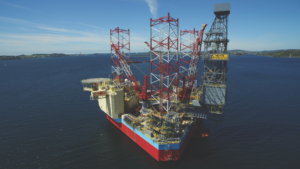
Maersk Drilling has secured a two-well contract extension from Aker BP for the Maersk Integrator, an ultra-harsh environment, low-emissions jackup rig. In direct continuation of the rig’s current workscope, the Maersk Integrator will move to the Ivar Aasen field offshore Norway to drill two wells, with work expected to commence in October 2020. The extension has an estimated duration of 93 days and a contract value of approximately $25.5 million, excluding a potential performance bonus. The contract includes a one-well option.
The Maersk Integrator is contracted under the terms of the alliance agreement Maersk Drilling entered into with Aker BP and Halliburton in 2017. Contracts under the alliance are based on market-rate terms but add the possibility of an upside for all parties, based on actual delivery and performance.
Disappointing results at Marina-1 well offshore Peru
The Marina-1 exploration well, located in the Tumbes Basin offshore Peru, did not encounter significant hydrocarbons and will now be plugged and abandoned, operator Karoon Energy said in a statement.
Mudlogging and LWD logging results from the primary targets in the Tumbes formation indicated that the well had encountered thin water-bearing sands with no oil and only minor gas shows.
Karoon said that Marina-1 provided a “large amount of valuable data” for the geological setting for that region of the Tumbes Basin. While it encountered several potential reservoir sequences in the well, those sections were water wet. Karoon said it is analyzing the well results and that no further drilling is planned in Block Z-38 for this campaign.
CNOOC’s Bozhong 34-9 oilfield starts production
CNOOC announced that the Bozhong 34-9 oilfield has commenced production. The Bozhong 34-9 oilfield is located in the south of Bohai Sea, with an average water depth of 18.1 m.
In addition to fully utilizing the existing facilities of the Kenli oilfield, the major production facilities include a central platform and a wellhead platform. A total of 57 producing wells are planned, including 38 production wells and 19 water injection wells. The project is expected to reach its peak production of approximately 22,500 bbl of crude oil per day in 2022.
Gas module boosts Fram field production
Equinor has announced that a new gas module that was recently put on stream on the Troll C platform will accelerate and boost production from Fram by substantial profitable volumes. The gas module was lifted into place on 16 May 2019 and will boost the gas-processing capacity on Troll C by a total of 3.5 million cu m/day.
BP, Equinor outline carbon reduction roadmaps
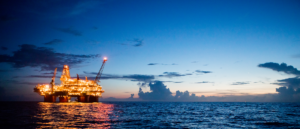
Two major IOCs recently announced roadmaps to achieve reductions in carbon intensity.
BP has set a goal to become a net-zero company by 2050 or sooner and to help the world get to net zero. The ambition is supported by 10 aims:
- Net zero across BP’s operations on an absolute basis by 2050 or sooner.
- Net zero on carbon in BP’s oil and gas production on an absolute basis by 2050 or sooner.
- 50% cut in the carbon intensity of the products BP sells by 2050 or sooner.
- Install methane measurement at all BP’s major oil and gas processing sites by 2023 and reduce methane intensity of operations by 50%.
- Increase the proportion of investment into non-oil and gas businesses over time.
- More active advocacy for policies that support net zero, including carbon pricing.
- Further incentivize BP’s workforce to deliver aims and mobilize them to advocate for net zero.
- Set new expectations for relationships with trade associations.
- Aim to be recognized as a leader in the transparency of reporting, including supporting the recommendations of the Task Force on Climate-related Financial Disclosures.
- Launch a new team to help countries, cities and large companies decarbonize.
Separately, Equinor recently launched a new climate roadmap aiming to ensure a competitive and resilient business model in the energy transition, fit for long-term value creation and in line with the Paris Agreement. Equinor aims to:
- Reduce the net carbon intensity, from initial production to final consumption, of energy produced by at least 50% by 2050;
- Grow renewable energy capacity tenfold by 2026, developing as a global offshore wind major; and
- Strengthen its position on carbon-efficient production, aiming to reach carbon-neutral global operations by 2030.
By 2050, each unit of energy produced will, on average, have less than half of the emissions compared with today.
Equinor plans to meet the ambition primarily through significant growth in renewables and changes in the scale and composition of its oil and gas portfolio. The efficiency of its oil and gas operations also will play a key role. Carbon-efficient production of oil and gas will increasingly become a competitive advantage, and Equinor will seek to ensure a high value and robust oil and gas portfolio.
In January, Equinor announced ambitions to reduce absolute greenhouse gas emissions from its operated offshore fields and onshore plants in Norway by 40% by 2030, 70% by 2040 and toward near zero by 2050.
The ambition can be realized through electrification projects, energy efficiency measures and new value chains such as carbon capture and storage and hydrogen.
Equinor is aiming to reduce the CO2 intensity of its globally operated oil and gas production to below 8 kg per barrel of oil equivalent by 2025, five years earlier than the previous ambition. The current global industry average is 18 kg CO2 per barrel.
Equinor to discontinue Stromlo-1 exploration plan offshore south Australia
Equinor has informed the Australian authorities of its decision to discontinue its exploration drilling plan, Stromlo-1, in the Ceduna sub-basin offshore South Australia.
Following a holistic review of its exploration portfolio, Equinor concluded that the project’s potential is not commercially competitive compared with other exploration opportunities in the company.
Equinor has informed the federal, South Australian and local authorities about its decision. The company entered the licences in the Ceduna sub-basin as a partner in 2013 and took over as operator with a 100% equity share in 2017.
Energean: Karish Main-02 production results prove successful
Energean Oil and Gas has announced successful results from production measurement performed during cleanup of the Karish Main-02 development well, located on the crest of the Karish Main structure, in the Mediterranean Sea.
KM-02 produced from a 35-m interval of the C sand reservoir. The well flowed at a maximum rate of 120 million standard cu ft/day of natural gas, limited by surface equipment. Performance modeling confirms the well is capable of delivering at the 300 million cu ft/day design capacity when connected to the FPSO.
Kosmos: Valaris 8503 to plug and abandon Oldfield well, move to new infill well on Kodiak field
Kosmos Energy has completed drilling the Oldfield exploration well in the US Gulf of Mexico. Oldfield was designed to test a sub-salt Miocene prospect located in Mississippi Canyon. The well did not encounter commercial quantities of hydrocarbons and will now be plugged and abandoned.
Following the abandonment of the Oldfield well, the Valaris 8503 rig will move to the Kodiak field to begin drilling and completion operations on a new infill producer well. Kosmos plans to drill three additional infrastructure-led exploration wells in the Gulf of Mexico in 2020.

